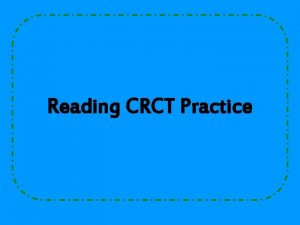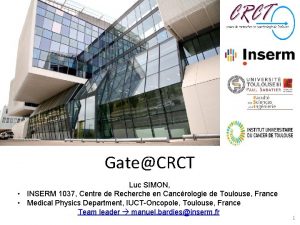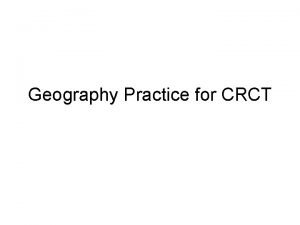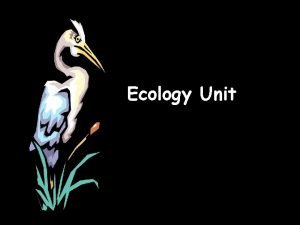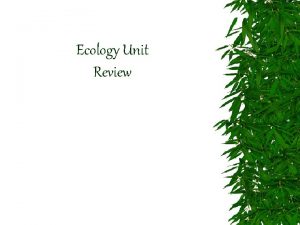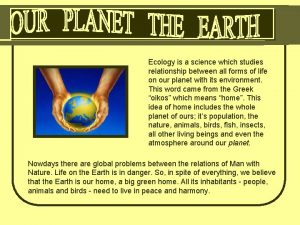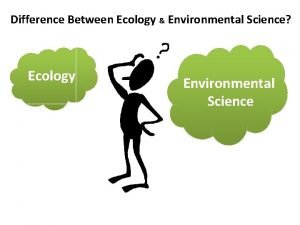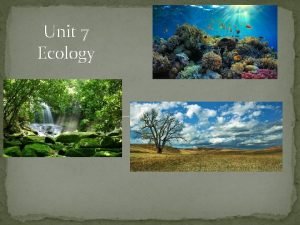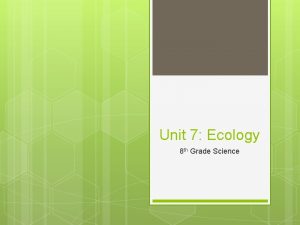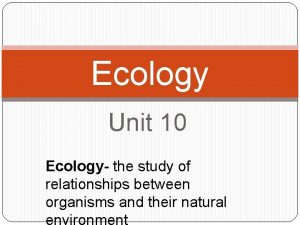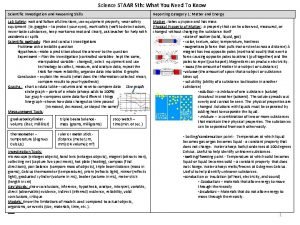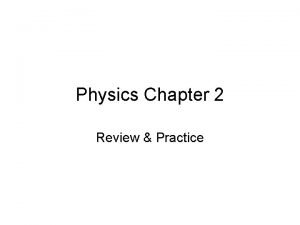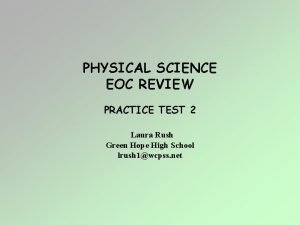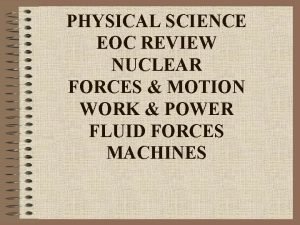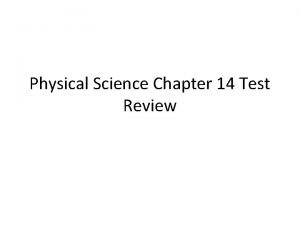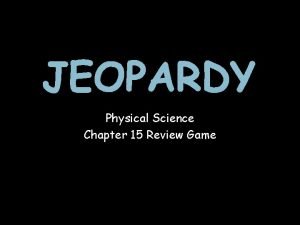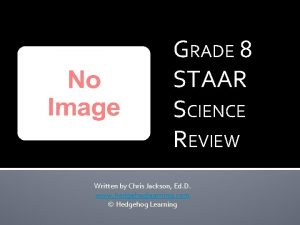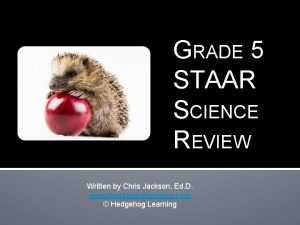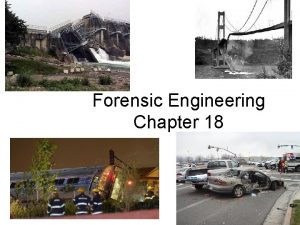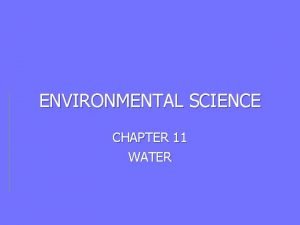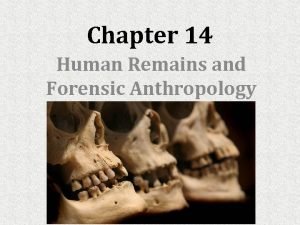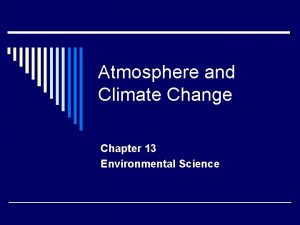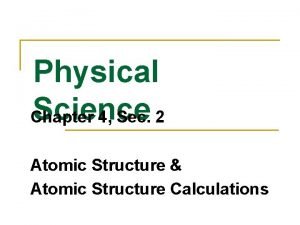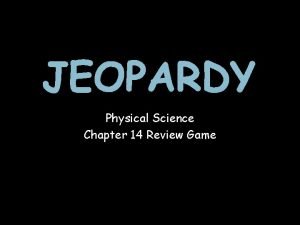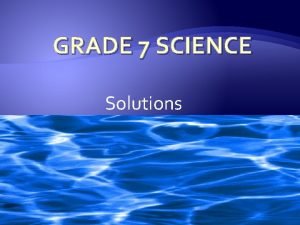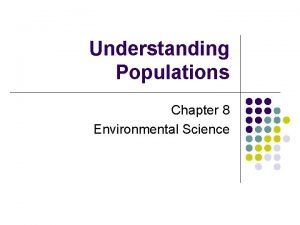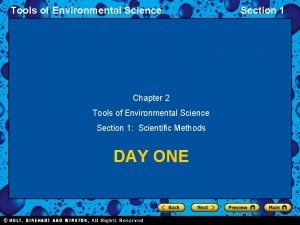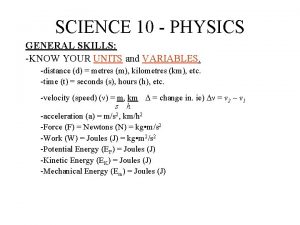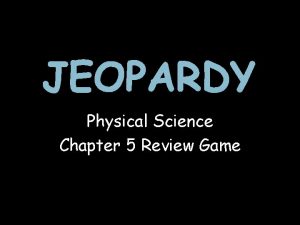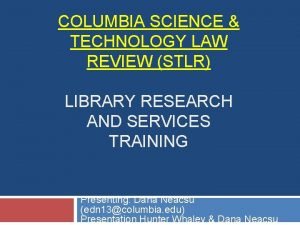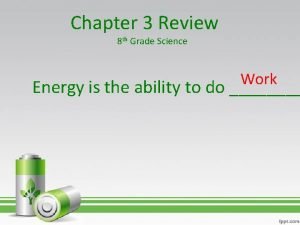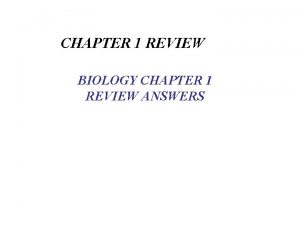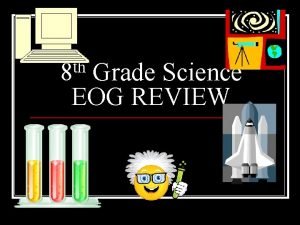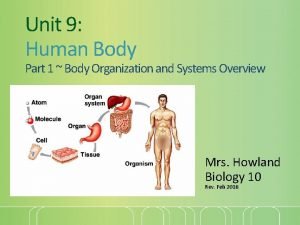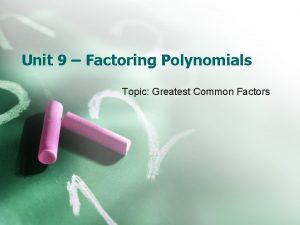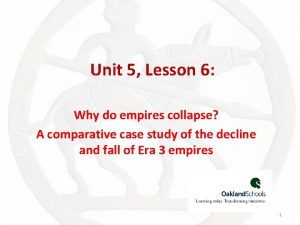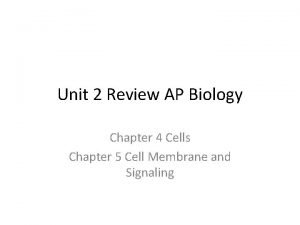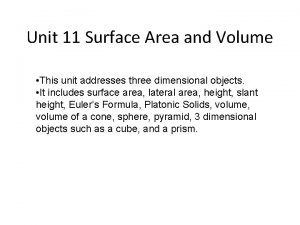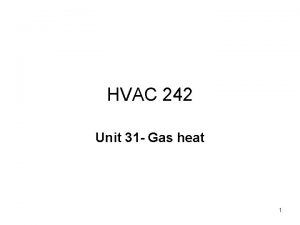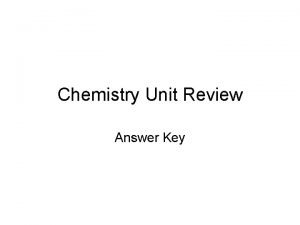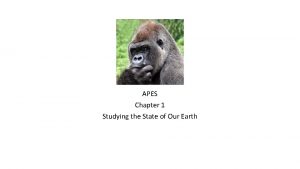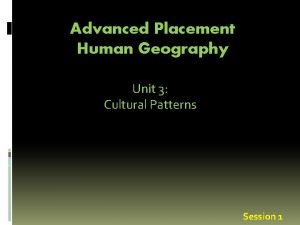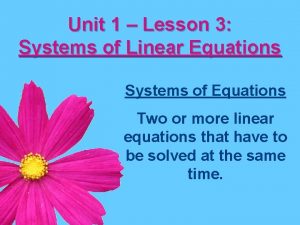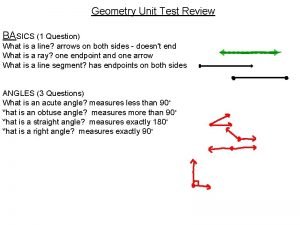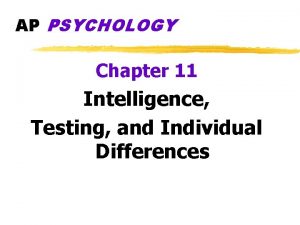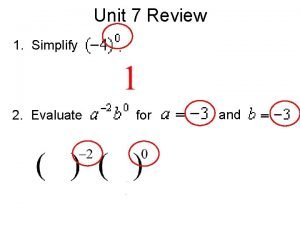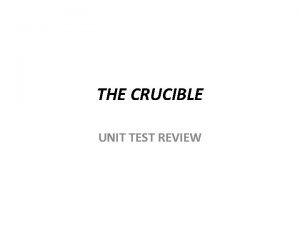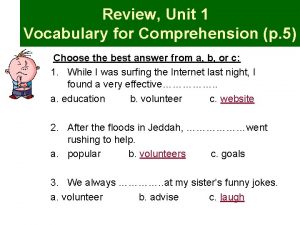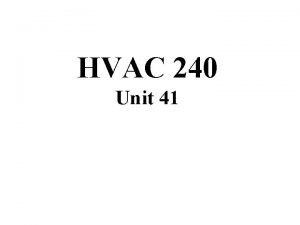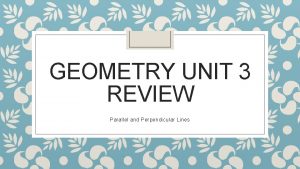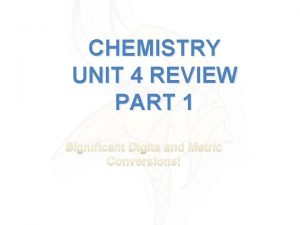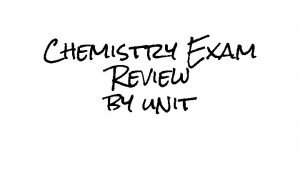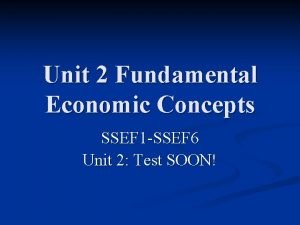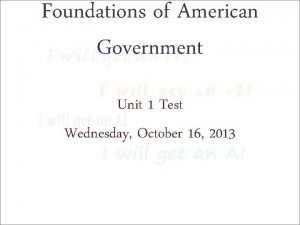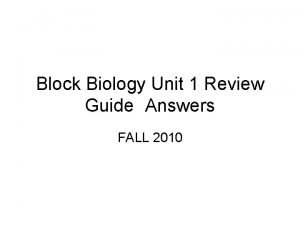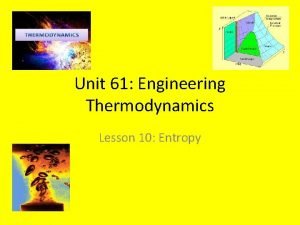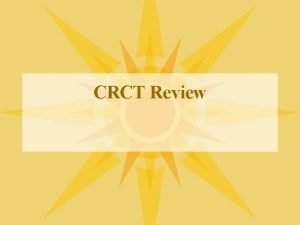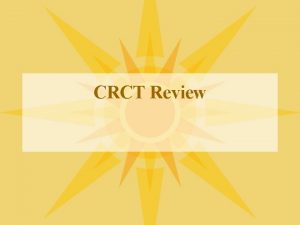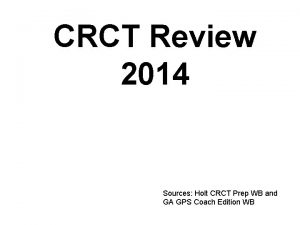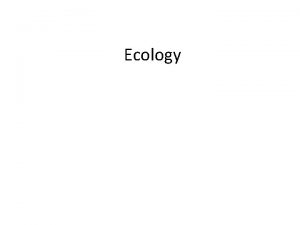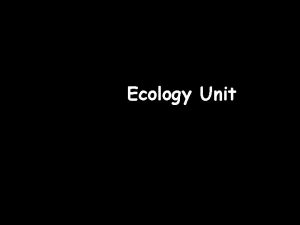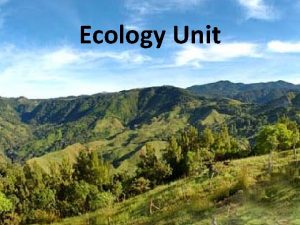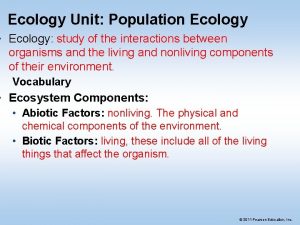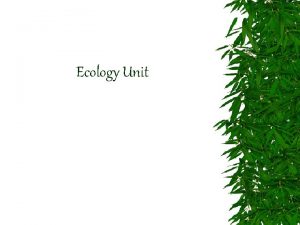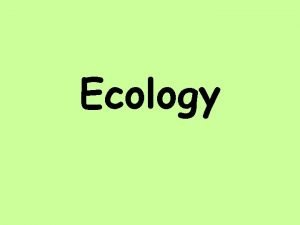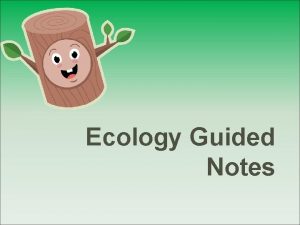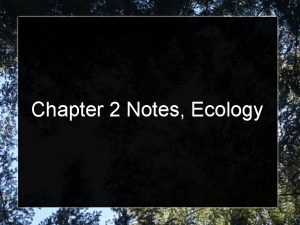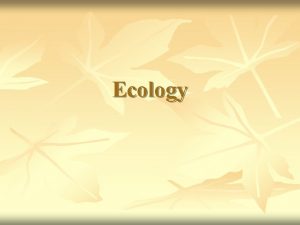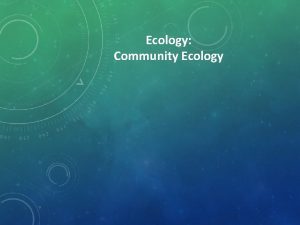Science Review for CRCT Ecology Unit What are
















































































































































































- Slides: 176

Science Review for CRCT

Ecology Unit

What are the levels of Ecological organization from smallest to largest?

Organism Population Community Ecosystem

Organism

One member of one species

Population

All the members of a species in an area Ex: all the people in this room

Community

All the members of all species in an area Ex: all the people, bacteria, insects in the room

Ecosystem

All the biotic and abiotic factors in an area Ex: people, bacteria, insects, light, temperate, water, desks, and humidity in this room

Autotroph

An organism that can make its own food

What are the 3 types of symbiosis?

Mutualism Commensalism Parasitism

Mutualism

A type of symbiosis where BOTH organisms benefit Ex:

Commensalism

A type of symbiosis where ONE organism benefits and ONE organism is neither harmed or helped Ex:

Parasitism

A type of symbiosis where ONE organism BENEFITS and ONE is HARMED Ex:

Parasite and host

Parasite: The organism in parasitism that benefits Host: the organism in parasitism that is harmed

Predation

A relationship where one organism hunts and KILLS another

Predator and prey

Predator: the organism in predation that KILLS Prey: the organism in predation that IS KILLED

Competition

Where 2 or more organisms struggle for a common resource (food, water, shelter, etc. )

Food chain

A series of events hows the flow of energy from one organism to another in an ecosystem Sun flower rabbit bobcat

Food Web

Several together food chains interconnected

Heterotroph

An organism that CANNOT produce its own food

Get ready for……. .

Biomes

Describe a tropical rainforest

Close to the equator Warm temperatures that don’t vary much (20 -25 C) LOTS of rain (200 -1000 cm/yr) LOTS of plant and animal species

Describe a desert

Large temperature shifts from day to night (-4 to 38 C) LESS than 25 cm of rain a year Organisms are adapted to little rainfall

Describe a Savannah

Temperatures are more comfortable than a desert 25 -about 100 cm of rainfall Rich soil (grasses, shrubs, and small trees)

Describe a Temperate Forest

Seasons with temperature changes (30 to 30 C) 50 – 150 cm of rain a year Deciduous trees (trees that lose their leaves in winter)

Describe a Taiga

Colder than a temperate forest (with very cold, often snowy winters and warm, rainy summers) Coniferous trees (trees that have needles and keep them in winter)

Describe a tundra

Largest and most northern biome Extremely cold and dry (-40 to 18 C) Permafrost- frozen soil LITTLE rainfall (less than 25 cm/yr Plant species are short and low to the ground

Describe a freshwater biome

Includes ponds, lakes, rivers, swamps, marsh, and streams Vary in location around the world, but most larger lakes are in North America

Describe the marine biome

Oceans Temperature, rainfall, and species will depend on ocean and location in it.

Describe estuaries

Areas of shallow sunlight water around the world Nutrient rich soil Supports lots of diverse species

Ready for…….

Cells

Passive Transport

A type of movement across a cell membrane the requires LITTLE or NO ENERGY From an area of HIGH concentration to LOW concentration

Diffusion

Movement of MOLECULES requiring little or no energy

Osmosis

The movement of WATER requiring little or no energy

Active Transport

A type of movement across a cell membrane the requires A LOT of ENERGY From an area of LOW concentration to HIGH concentration

Engulfing

A form of active transport where the cell membrane BENDS and SUROUNDS a particle and forms a vacuole around it.

Transport Protein

A form of active transport where a protein PICKS UP and CARRIES a material across a cell membrane

Selectively Permeable

The term which refers to a cell membrane’s ability to determine what can enter or leave a cell

Photosynthesis

The process by which a plant cell captures sunlight to produce glucose

Formula for Photosynthesis

6 H 2 O + 6 CO 2 ATP C 6 H 12 O 6 + 6 O 2

Respiration

The process by which cells break down glucose to produce ENERGY

Equation for cellular respiration

C 6 H 12 O 6 + 6 O 2 6 CO 2 + 6 H 2 O + ATP

Stages of mitosis

Prophase Metaphase Anaphase Telophase

Organic compounds

Compounds Ex: that contain CARBON proteins, carbohydrates, lipids, nucleic acids

Inorganic Compounds

Compounds that DO NOT contain CARBON Ex: water, oxygen, carbon dioxide (the exception to the rule)

Cell membrane

The organelle that surrounds the cell and determines what can enter and leave the cell (selectively permeable) Memory device: Door

Nucleus

The control center of the cell. Controls other cell functions. Also contains the DNA Memory device: Brain ***Not found in bacteria cells***

Mitochondria

Produces energy for the cell. The “powerhouse” of the cell Memory device: Muscles

Cytoplasm

The gel-like liquid which holds most of the cell organelles Memory device: jello

Chloroplast

The GREEN organelle found in plant cells that captures the sunlight to produce glucose for the cell. Memory device: solar panels

Get ready for…….

Human Body Systems

Which systems work together for HOMEOSTASIS?

Nervous Excretory Integumentary (skin)

Which systems work together for EXCRETING WASTES?

Excretory Digestive Respiratory Circulatory Integumentary

Which systems work together for MOVING/RUNNING?

Muscular Skeletal Nervous Respiratory Circulatory

Which systems work together for FIGHTING PATHOGENS?

Immune Lymphatic Circulatory

Which systems work together for SENDING SIGNALS?

Nervous Endocrine Circulatory

Which systems work together for EXCHANGE OF 02 AND CO 2 ?

Respiratory Circulatory

Which systems work together for TAKING FOOD/NUTRIENTS TO CELLS?

Digestive Circulatory

Which systems work together for MAKING OFFSPRING?

Reproductive Endocrine

Get ready for…….

Genetics

Allele

Half of a gene and codes for a specific trait Ex: T, r, e, B

Gene

Two alleles paired together to code for a trait Ex: EE, Hh, uu, YY

Chromosome

1000’s of genes together coding for many traits ***Humans have 46 total***

Homozygous

Having Ex: the SAME alleles for a trait KK, dd, AA

Heterozygous

Having Ex: DIFFERENT alleles for a trait Ww, Ss, Mm

Purebred

An organism that always produces offspring with the SAME TRAITS as it.

Hybrid

An organism that has different alleles for a trait

Genotype

An organism’s genetic make up Ex: TT, Rr, dd

Phenotype

An Ex: organism’s physical characteristics hair color, eye color, skin color, height, number of toes

Trait

Physical organism characteristics of an

Selective Breeding

The process of determining which traits are passed on from parent to offspring Two types: hybridization and inbreeding


Asexual Reproduction

One parent passing on its genetic information directly

Which kinds of organisms reproduce asexually?

ALL bacteria (Binary fission) Protists Plants and fungi can

Sexual Reproduction

Having 2 parents pass on HALF of their genetic material to offspring

Which organisms reproduce sexually?

Almost Plants all Animals do usually do Bacteria Protists (conjugation) and fungi can

Get ready for…….

Evolution

Evolution

The time gradual change in a species over

Natural selection

The process where organisms that are better adapted to their environment are more likely to survive and reproduce Survival of the fitest

Mimicry

Where one organism looks like another organism for the goal of surviving

Camoflauge

When an organism attempts to blend into the environment for the goal of surviving in the environment

Venom

Poison produced by some predators for the purpose of capturing prey

Fossil

The preserved remains of organisms in the past

Sedimentary Rock

The form of rock in which most fossils are found

2 types of evolution

Gradualism Punctuated equilibria

Gradualism

When evolution occurs SLOWLY over a LONG PERIOD of time

Punctuated equilibria

When evolution occurs RAPIDLY in SHORT BURSTS

Get ready for ……. .

Classification

Name the 6 kingdoms from simplist to most complex

Archebacteria Eubacteria Protist Fungi Plantea (plants) Animalia (animals)

Name the 7 levels of classification from largest to smallest

Kingdom Phylum Class Order Family Genus Species

THE END : )
 Antigentest åre
Antigentest åre Crct practice
Crct practice Crct cmh
Crct cmh What river is this
What river is this Ecology unit review
Ecology unit review Fatality
Fatality Unit 10, unit 10 review tests, unit 10 general test
Unit 10, unit 10 review tests, unit 10 general test What's your favourite school
What's your favourite school Locard's exchange principle
Locard's exchange principle Ecology is a science which studies the relationship between
Ecology is a science which studies the relationship between Ecology and environmental science difference
Ecology and environmental science difference Unit 1 test algebra 2 answers
Unit 1 test algebra 2 answers Unit 7 ecology answer key
Unit 7 ecology answer key Unit 7 ecology answer key
Unit 7 ecology answer key Which of the following tells you population density
Which of the following tells you population density Biological magnification
Biological magnification Fspos vägledning för kontinuitetshantering
Fspos vägledning för kontinuitetshantering Novell typiska drag
Novell typiska drag Tack för att ni lyssnade bild
Tack för att ni lyssnade bild Ekologiskt fotavtryck
Ekologiskt fotavtryck Varför kallas perioden 1918-1939 för mellankrigstiden?
Varför kallas perioden 1918-1939 för mellankrigstiden? En lathund för arbete med kontinuitetshantering
En lathund för arbete med kontinuitetshantering Personalliggare bygg undantag
Personalliggare bygg undantag Tidbok yrkesförare
Tidbok yrkesförare A gastrica
A gastrica Vad är densitet
Vad är densitet Datorkunskap för nybörjare
Datorkunskap för nybörjare Boverket ka
Boverket ka Debatt mall
Debatt mall Autokratiskt ledarskap
Autokratiskt ledarskap Nyckelkompetenser för livslångt lärande
Nyckelkompetenser för livslångt lärande Påbyggnader för flakfordon
Påbyggnader för flakfordon Vätsketryck formel
Vätsketryck formel Svenskt ramverk för digital samverkan
Svenskt ramverk för digital samverkan Kyssande vind
Kyssande vind Presentera för publik crossboss
Presentera för publik crossboss Jiddisch
Jiddisch Kanaans land
Kanaans land Klassificeringsstruktur för kommunala verksamheter
Klassificeringsstruktur för kommunala verksamheter Fimbrietratt
Fimbrietratt Bästa kameran för astrofoto
Bästa kameran för astrofoto Cks
Cks Programskede byggprocessen
Programskede byggprocessen Mat för unga idrottare
Mat för unga idrottare Verktyg för automatisering av utbetalningar
Verktyg för automatisering av utbetalningar Rutin för avvikelsehantering
Rutin för avvikelsehantering Smärtskolan kunskap för livet
Smärtskolan kunskap för livet Ministerstyre för och nackdelar
Ministerstyre för och nackdelar Tack för att ni har lyssnat
Tack för att ni har lyssnat Mall för referat
Mall för referat Redogör för vad psykologi är
Redogör för vad psykologi är Borstål, egenskaper
Borstål, egenskaper Atmosfr
Atmosfr Borra hål för knoppar
Borra hål för knoppar Vilken grundregel finns det för tronföljden i sverige?
Vilken grundregel finns det för tronföljden i sverige? Beräkna standardavvikelse
Beräkna standardavvikelse Tack för att ni har lyssnat
Tack för att ni har lyssnat Steg för steg rita
Steg för steg rita Informationskartläggning
Informationskartläggning Tobinskatten för och nackdelar
Tobinskatten för och nackdelar Toppslätskivling dos
Toppslätskivling dos Gibbs reflekterande cykel
Gibbs reflekterande cykel Egg för emanuel
Egg för emanuel Elektronik för barn
Elektronik för barn Mantel som bars av kvinnor i antikens rom
Mantel som bars av kvinnor i antikens rom Strategi för svensk viltförvaltning
Strategi för svensk viltförvaltning Kung dog 1611
Kung dog 1611 Indikation för kejsarsnitt på moderns önskan
Indikation för kejsarsnitt på moderns önskan Romarriket tidslinje
Romarriket tidslinje Tack för att ni lyssnade
Tack för att ni lyssnade Tallinjen
Tallinjen Bunden till c-dur
Bunden till c-dur Inköpsprocessen steg för steg
Inköpsprocessen steg för steg Rådet för byggkompetens
Rådet för byggkompetens Etik och ledarskap etisk kod för chefer
Etik och ledarskap etisk kod för chefer Skivepiteldysplasi
Skivepiteldysplasi Myndigheten för delaktighet
Myndigheten för delaktighet Frgar
Frgar Sju principer för tillitsbaserad styrning
Sju principer för tillitsbaserad styrning Läkarutlåtande för livränta
Läkarutlåtande för livränta Karttecken kraftledning
Karttecken kraftledning Geometri för barn
Geometri för barn Shivaiter
Shivaiter Meios steg för steg
Meios steg för steg Bris för vuxna
Bris för vuxna Big brother rösta
Big brother rösta Chapter review motion part a vocabulary review answer key
Chapter review motion part a vocabulary review answer key Ap gov review final exam review
Ap gov review final exam review Narrative review vs systematic review
Narrative review vs systematic review Narrative review vs systematic review
Narrative review vs systematic review Narrative review vs systematic review
Narrative review vs systematic review Reporting category 3 earth and space
Reporting category 3 earth and space Earth science practical review
Earth science practical review Physrt
Physrt Physical science eoc study guide
Physical science eoc study guide Physical science eoc review
Physical science eoc review Chapter 4 section 1 work and machines answer key
Chapter 4 section 1 work and machines answer key Chapter 14 physical science test
Chapter 14 physical science test Chapter 15 review physical science
Chapter 15 review physical science Day 8 8th grade science staar review
Day 8 8th grade science staar review Hedgehog learning 5th grade science
Hedgehog learning 5th grade science 8th grade science mcas review
8th grade science mcas review The golden book of camping
The golden book of camping End of semester test environmental science b edmentum
End of semester test environmental science b edmentum Environmental science chapter 11
Environmental science chapter 11 Earth science sol
Earth science sol Nibis ballistics definition
Nibis ballistics definition Forensic anthropology unit
Forensic anthropology unit Environmental science chapter 13
Environmental science chapter 13 Physical science chapter 4 review
Physical science chapter 4 review Chapter 14 review physical science
Chapter 14 review physical science Solutions grade 7
Solutions grade 7 Environmental science chapter 8 review answer key
Environmental science chapter 8 review answer key Tools of environmental science
Tools of environmental science Science 10 physics review
Science 10 physics review Earth science review book
Earth science review book Physical science final exam
Physical science final exam Chapter 5 review physical science
Chapter 5 review physical science Earth science final exam review
Earth science final exam review Earth science prologue review
Earth science prologue review Physical science chapter 6 review answers
Physical science chapter 6 review answers Columbia science and technology law review
Columbia science and technology law review Chapter 3 review 8th grade science
Chapter 3 review 8th grade science Biology chapter 1 review answer key
Biology chapter 1 review answer key What are the 3 levels of biodiversity
What are the 3 levels of biodiversity 8th grade science eog
8th grade science eog Chapter 16 review physical science
Chapter 16 review physical science Social science vs natural science
Social science vs natural science Branch of natural science
Branch of natural science Natural science vs physical science
Natural science vs physical science Applied science vs pure science
Applied science vs pure science Natural science and social science similarities
Natural science and social science similarities Extra credit
Extra credit Rule of 70 in population growth
Rule of 70 in population growth Julie lundquist
Julie lundquist Soft science definition
Soft science definition Unit 9 human body systems review
Unit 9 human body systems review Unit 9 factoring review answers
Unit 9 factoring review answers What type of angle is this
What type of angle is this Unit 8 exponential and logarithmic functions
Unit 8 exponential and logarithmic functions Unit 7 lesson 5 review questions
Unit 7 lesson 5 review questions World history unit 5 lesson 6
World history unit 5 lesson 6 Ap biology unit 2 review
Ap biology unit 2 review Unit 11 volume and surface area homework 4
Unit 11 volume and surface area homework 4 Chemistry semester 2 review unit 12 thermochemistry
Chemistry semester 2 review unit 12 thermochemistry Khubris
Khubris Apush period 3 review
Apush period 3 review Unit 31 gas heat review questions
Unit 31 gas heat review questions Hamlet unit test answers
Hamlet unit test answers Chemistry unit review answer key
Chemistry unit review answer key Geometry unit 1 review
Geometry unit 1 review Stranger at our gate
Stranger at our gate Surrogate families apush
Surrogate families apush Apes unit 1 review
Apes unit 1 review Ap psych social psychology
Ap psych social psychology Unit 2 ap gov review
Unit 2 ap gov review Ap human geography unit 3 review
Ap human geography unit 3 review Unit 1 lesson 3 review of linear systems
Unit 1 lesson 3 review of linear systems Unit test review geometry
Unit test review geometry Ap psychology unit 11 practice test
Ap psychology unit 11 practice test Unit 2 test algebra 1
Unit 2 test algebra 1 Unit 7 review
Unit 7 review Government study guide unit 1
Government study guide unit 1 Elizabeth proctor was accused because _____.
Elizabeth proctor was accused because _____. Review unit 1 vocabulary
Review unit 1 vocabulary Personal finance unit 1 review
Personal finance unit 1 review Unit 29 hvac
Unit 29 hvac Chapter 3 review parallel and perpendicular lines
Chapter 3 review parallel and perpendicular lines Honors chemistry unit 4 review answers
Honors chemistry unit 4 review answers Unit 6 chemistry review
Unit 6 chemistry review Ssef price list
Ssef price list Unit 1 test review us history
Unit 1 test review us history Pre calculus unit 1 review
Pre calculus unit 1 review Foundations of american government unit test
Foundations of american government unit test Biology unit 1 review answers
Biology unit 1 review answers Unit 8 test review
Unit 8 test review Lesson 10: thermodynamics unit review
Lesson 10: thermodynamics unit review

